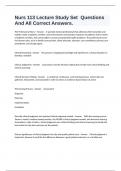Nurs 113 Lecture Study Set Questions
And All Correct Answers.
The Professional Nurse - Answer A specially trained professional that addresses the humanistic and
holistic needs of patients, families, and environments and provides responses to patterns and/or needs
of patients, families, and communities to actual and potential health problems. The professional nurse
has diverse roles, such as health care provider, client advocate, educator, care coordinator, primary care
practitioner, and change agent.
Clinical Reasoning - Answer The process of applying knowledge and expertise to a clinical situation to
develop a solution
Clinical Judgement - Answer Conclusions and the decision making that results from critical thinking and
clinical reasoning
Clinical Decision Making - Answer a contextual, continuous, and evolving process, where data are
gathered, interpreted, and evaluated in order to select an evidence-based choice of action
The Nursing Process - Answer Assessment
Diagnosis
Planning
Implementation
Evaluation
Describe clinical judgment and selected clinical judgment models - Answer With the nursing process,
Tanner's model, evidence-based practice, the NCSBN's clinical judgment model, and American Nursing
Association's code of ethics, clinical judgment uses critical thinking and clinical reasoning to decide the
best action for the best outcome for the patient.
Discuss significance of clinical judgment to safe and quality patient care - Answer Clinical judgment is
important, because it could be the difference between a great patient outcome, or a terrible one.
,Patient safety is an outcome of quality patient care by way of sound clinical judgment.
When bad clinical judgment is used, medical errors occur. Errors of omission are errors where something
it "omitted" or "forgotten". Errors of commission are errors where someone "committed" the WRONG
action.
Discuss the use of clinical judgment models in the care of patients, families and populations across the
lifespan - Answer From infant to elder, when addressing the needs of a patient, and using clinical
judgment, to provide the best care, all clinical judgement models are based on and the extension of the
nursing process which is to assess, diagnose, plan, implement, and evaluate patient care with the best
clinical judgment.
In the care of patients, their families, and different populations, nurses assess, diagnose, plan,
implement, respond, generate solutions and form hypothesis to come to the best clinical judgment
solutions.
Discuss the importance of safe medication administration - Answer It is important to be sure that as a
nurse, we are implementing the 11 rights of medication administration.
It is important to use 2 checks (full name and DOB)
We have to be sure as well as check within those rights at least three times (three checks) before
administration.
11 rights of medication administration - Answer 1. right medication
2. right patient
3. right dosage (in the right form)
4. right route
5. right time
6. right reason
7. right (appropriate) assessment data
8. right documentation
, 9. right response
10. right to education
11. right to refuse
Discuss legal and ethical considerations in clinical decision making - Answer Every decision made as a
nurse needs to be for the ethical and legal benefit of the patient and their overall care. Giving the patient
the choice, avoiding harm, treating them with equal respect and not putting them is ethical. Securing
their privacy, taking personal care of them, being safe, using equipment properly, keeping them involved
in every decision for tests and decisions are legal considerations.
Discuss the significance of evidence based nursing practice in clinical decision making - Answer In order
to have sound clinical judgment and sound rationale, the actions we take need to be based on the
evidence that they are appropriate and effective.
For evidence to be sound, it must be tested, and proven with studies trials and reviews. This is significant
because it promotes and secures a systematic way of approaching care.
Discuss health education strategies in promoting health of patients and families - Answer Assessing -
the learning needs and readiness of the patient
Diagnosing - the patient and their caretaker's learning needs
Planning - (developing outcomes) of learning/teaching
Implementation - the teaching plan
Evaluate - whether or not the teaching plan/assessment/ needs of patient and their learning met
The nurse should begin teaching at the first encounter, and keep patient education patient centered.




